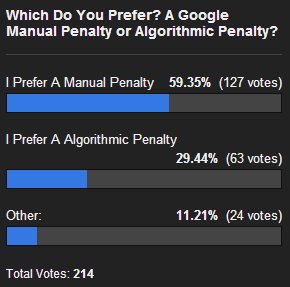To score a prime position on the first page of Google search results, brands must play by the engine’s optimization rules. Unfortunately, there are a lot of them. More than 500 ranking signals determine whether each domain’s web content is considered topnotch or punishable. Additionally, Google’s webspam team manually penalizes pages found using deceptive practices or spamming the ‘net. According to a recent poll by the Search Engine Roundtable, marketers feat algorithmic updates more than anything else.
A survey shows the majority of respondents would prefer to be hit by a manual penalty (just under 60 percent) than an algorithm (around 29 percent).

This seems natural for two reasons. The first being that Panda and Penguin have been SEO game-changers, dumping domains at the bottom of SERPs for buying backlinks or publishing low-quality online content. Adding to their search engine marketing woes, marketers were not given explicit examples about what they would need to remove to recover. On the other hand, Google recently announced it would take the guesswork out of manual webspam actions by listing specific examples to point SEOs in the right direction.
Of course, the best case scenario is to receive no penalties, an option that is available to marketers who prioritize continuous high-quality content creation over short-lived SEO trends.




